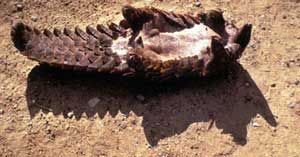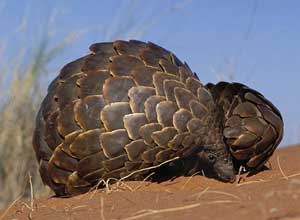African Pangolin
The African Pangolin is named Manis temminckii, who sleeps in a cave during the day, and they point out to search for the nightfall. Pangolins can occupy caves that have been abandoned by rabbits, piggy banks or other animals as shelter, or dig for themselves. The cave is dug with a diameter of 15-20cm and a few meters deep.
 Manis temminckii numbness often lives in a dry place, all their activities are mainly on the ground, but when necessary they can climb and wade. They moved slowly on the ground, lifting their entire bodies with their hind legs and tail.
Manis temminckii numbness often lives in a dry place, all their activities are mainly on the ground, but when necessary they can climb and wade. They moved slowly on the ground, lifting their entire bodies with their hind legs and tail.
Their heads are cone-shaped with two tiny ears, but they do not have the ear but they sound good. The body is numb about 50cm long, the tail is about 35cm long, weighs about 9kg. Long protruding muzzle, 3 of the 5 toes in the foreleg have large, long and strong claws, and the hindquarters are smaller. Their whole body is scaly, looking like a human being from the Americas (these two animals are completely different). The sight is poor, the sense of smell is so sensitive that in the dark darkness they are still easy to find bait, they have an extremely stinking odor used to drive away the enemy.
Pangolin Manis temminckii loves to eat insects, especially ants and termites. They can dig up any termite but often they sniff to find the type of relationship they like. They used claws to dig through mounds, using blades about 40cm long to catch ants and termites. The large salivary glands in the pangolin mouth keep their tongue moist, making it easier for ants and termites to stick to the tongue without being able to escape. When he did not catch food, his numbness placed his tongue in a bag deep in his throat. In addition to the way to search for it, pangolin Manis temminckii also has a more unique way: for ants and termites to crawl all over the body, opening the flakes, then closing these gaps to make the insects crushed. Until then, numbness kept slowly eating insects.
 Even without teeth, this pangolin stomach can still digest well. The digestion of food is helped by pebbles and small stones that numb the stomach.
Even without teeth, this pangolin stomach can still digest well. The digestion of food is helped by pebbles and small stones that numb the stomach.
Pangolin is the only mammal that has large scales , all of them have scales, except the muzzle, chin, throat, sides of the face and abdomen. If attacked, the pangolin will curl up like a ball. Because scales are very hard, they have to spend a lot of effort to roll up. It is very difficult to pry a pangolin out of that curled shape. This scale is very hard, can withstand the bullet fired from some small guns.
Pangolins can also whip the tail to injure the attackers and prevent the beast from pulling it out of its curled shape. These scales have sharp edges that can seriously hurt the enemy.
Much of the life of pangolin Manis temminckii lived alone. They only live in pairs for a short time at mating. Males also fight fiercely to win children. After about 140 days of pregnancy, her mother gave birth to only one calf. At birth, the calf is about 15cm long and weighs about 300g. Their soft blue scales begin to harden on the second day after birth. Young children start eating termites when they are 1 month old, and they are cared for by mothers for 3-4 months; if it is dangerous, it crawls under the womb and the mother rolls over to protect it.
Newspapers and other large animals (like hyenas) often eat pangolin, although the pangolins are completely safe from small carnivores. However, humans are the cause of the most damage to pangolin . Pangolin is believed to be the source of magic and charm. When mixed with the shells of certain plants, the scales of pangolins are used to solve spells and ward off demons. People also use pangolin scales as a wristband, as a charm. Aboriginal people in African tribes also believe that if a woman buryes these scales down near a man's door, the woman will be able to dictate the enchanted man.

Occasionally, pangolin scales are burned to ward off lions and other beasts; In some places, pangolins are also sacrificed when praying for rain. People also catch pangolins to eat meat, many tribes said that they can use scales as medicine to have a powerful effect. Each scale is sold for about $ 17, and their skin can be used as a shoe because it is very durable and beautiful, so the pangolin is often killed for skin.
African Pangolin is one of the most difficult animals to keep in captivity. In nature they live about 20 years of age, they are also on the verge of extinction.
- Pangolin faces the threat of extinction from humans
- American newspapers call for protection of pangolin in Vietnam
- Re-release Java pangolin into nature
- Fossilized 3.5 million years of pangolin in Argentina
- Successful farming of two pangolin species in Cuc Phuong garden
- Pangasius faces an increasing risk of extinction
- 7 species of wild animals are being eradicated by humans
- Pangolin is in danger of extinction
- Death god stalks African elephants
- Not only rhinos and tigers, African lions will soon disappear
- African elephants have the first-class sensitive aces
- African elephants will decline by a fifth in the next 10 years
 Animal 'suffering' after hibernation
Animal 'suffering' after hibernation Why do goats climb well?
Why do goats climb well? Scientists were surprised to see chimpanzees eating turtles
Scientists were surprised to see chimpanzees eating turtles Giant catfish died deadly due to drought in Thailand
Giant catfish died deadly due to drought in Thailand